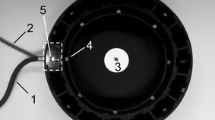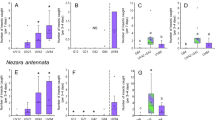Abstract
Nesidiocoris tenuis (Heteroptera: Miridae) is a zoophytophagous mirid bug that is used as a biological control agent for agricultural pests including whiteflies. N. tenuis is mass-reared commercially and can be easily bred on banker plants. However, there are still difficulties in establishing populations on crops. Light illumination is a promising candidate for recruiting N. tenuis to crop plants. In this study, we investigated whether N. tenuis has a particular spectral preference using a six-arm arena equipped with six monochromatic LED lights: UV (365 nm), violet (405 nm), blue (450 nm), green (525 nm), orange (590 nm), and red (660 nm). Adult bugs were introduced into the arena, and phototactic behavior was observed. A greater number of male bugs chose violet light, whereas female bugs chose violet and UV light equally. We next examined the effects of violet illumination in a tomato greenhouse. In conventional plots, bugs remained near banker plants, whereas in illuminated plots, bugs immediately dispersed from the plants and became uniformly distributed in the greenhouse. Based on these results, we conclude that violet is a promising wavelength for the recruitment and establishment of N. tenuis on crop plants.






Similar content being viewed by others
References
Abe J (2016) Insectary plants and indigenous natural enemies applicable for the conservation biological control. Mon J Agric Ext 53:19–21
Arnó J, Castañé C, Riudavets J, Gabarra R (2010) Risk of damage to tomato crops by the generalist zoophytophagous predator Nesidiocoris tenuis (Reuter) (Hemiptera: Miridae). Bull Entomol Res 100:105–115
Ben-Yakir D, Antignus Y, Offir Y, Shahak Y (2013) Optical manipulations: an advance approach for reducing sucking insect pests. In: Ishaaya I, Palli SR, Horowitz AR (eds) Advanced technologies for managing insect pests. Springer, New York, pp 249–267
Biondi A, Zappalà L, Di Mauro A, Garzia GT, Russo A, Desneux N, Siscaro G (2016) Can alternative host plant and prey affect phytophagy and biological control by the zoophytophagous mirid Nesidiocoris tenuis? BioControl 61:79–90
Böckmann E, Meyhöfer R (2017) Sticky trap monitoring of a pest–predator system in glasshouse tomato crops: are available trap colours sufficient? J Appl Entomol 141:339–351
Briscoe AD, Chittka L (2001) The evolution of color vision in insects. Annu Rev Entomol 46:471–510
Calvo J, Bolckmans K, Stansly P, Urbaneja A (2009) Predation by Nesidiocoris tenuis on Bemisia tabaci and injury to tomato. BioControl 54:237–246
Calvo FJ, Lorente MJ, Stansly PA, Belda JE (2012) Preplant release of Nesidiocoris tenuis and supplementary tactics for control of Tuta absoluta and Bemisa tabaci in greenhouse tomato. Entomol Exp Appl 143:111–119
Hinomoto N, Nagasaka Y, Goto C, Ohara S, Tedzuka T (2015) Biological control of Thrips tabaci by omnivorous predator Nesidiocoris tenuis on cucumbers in greenhouses. Ann Rep Kanto-Tosan Pl Prot Soc 62:125–129
Itou M, Watanabe M, Watanabe E, Miura K (2013) Gut content analysis to study predatory efficacy of Nesidiocoris tenuis (Reuter) (Hemiptera: Miridae) by molecular methods. Entomol Sci 16:145–150
Johansen NS, Vänninen I, Pinto DM, Nissinen AI, Shipp L (2011) In the light of new greenhouse technologies: 2. Direct effects of artificial lighting on arthropods and integrated pest management in greenhouse crops. Ann Appl Biol 159:1–27
Komi K (2016) Biological control of pest insects in greenhouse use of natural enemy in Kochi Prefecture. Jpn J Pestic Sci 41:69–73
Maeda T, Fujiwara-Tsujii N, Yasui H, Matsuyama S (2016) Female sex pheromone in trails of the minute pirate bug, Orius minutus (L). J Chem Ecol 42:433–443
Nakano R, Tsuchida Y, Doi M, Ishikawa R, Tatara A, Amano Y, Muramatsu Y (2016) Control of Bemisia tabaci (Gennadius) on tomato in greenhouse by a combination of Nesidiocoris tenuis (Reuter) and banker plants. Ann Rep Kansai Pl Prot 58:65–72
Nanya K, Ishigami Y, Hikosaka S, Goto E (2012) Effects of blue and red light on stem elongation and flowering of tomato seedlings. VII International Symposium on Light in Horticulture 956:261–266
NARO (2015) Manual for micro-pest control by Nesidiocoris tenuis. http://www.naro.affrc.go.jp/publicity_report/publication/laboratory/narc/manual/060741.html
Ogino T, Uehara T, Yamaguchi T, Maeda T, Yoshida NC, Shimoda M (2015) Spectral preference of the predatory bug Orius sauteri (Heteroptera: Anthocoridae). Jpn J Appl Entomol Zool 59:10–13
Ogino T, Uehara T, Muraji M, Yamaguchi T, Ichihashi T, Suzuki T, Kainoh Y, Shimoda M (2016) Violet LED light enhances the recruitment of a thrip predator in open fields. Sci Rep 6:32302. https://doi.org/10.1038/srep32302
Otani Y, Wakakuwa M, Arikawa K (2014) Relationship between action spectrum and spectral sensitivity of compound eyes relating phototactic behavior of the western flower thrips, Frankliniella occidentalis. Jpn J Appl Entomol Zool 58:177–185
R Core Team (2015) R: a language and environment for statistical computing. R Foundation for Statistical Computing, Vienna. https://www.r-project.org/
Rim H, Uefune M, Ozawa R, Takabayashi J (2015) Olfactory response of the omnivorous mirid bug Nesidiocoris tenuis to eggplants infested by prey: specificity in prey developmental stages and prey species. Biol Control 91:47–54
Rim H, Uefune AM, Ozawa R, Yoneya K, Takabayashi J (2017) Experience of plant infestation by the omnivorous arthropod Nesidiocoris tenuis affects its subsequent responses to prey-infested plant volatiles. BioControl 62:233–242
Sánchez JA, Lacasa A (2008) Impact of the zoophytophagous plant bug Nesidiocoris tenuis (Heteroptera: Miridae) on tomato yield. J Econ Entomol 101:1864–1870
Shimoda M, Honda K (2013) Insect reactions to light and its applications to pest management. Appl Entomol Zool 48:413–421
Tokushima Y, Uehara T, Yamaguchi T, Arikawa K, Kainoh Y, Shimoda M (2016) Broadband photoreceptors are involved in violet light preference in the parasitoid fly Exorista Japonica. PLoS ONE 11(8):e0160441. https://doi.org/10.1371/journal.pone.0160441
Uehara T, Yamaguchi T, Kotaki T, Shimoda M (2014) Evaluation of phototactic behavior by two-dimensional open field test in the brown-winged green bug, Plautia stali (Scott) (Hemiptera: Pentatomidae). Jpn J Appl Entomol Zool 58:36–38
Urbaneja A, Tapia G, Stansly P (2005) Influence of host plant and prey availability on developmental time and survivorship of Nesidiocoris tenuis (Het.: Miridae). Biocontrol Sci Techn 15:513–518
Vacante V, Cocuzza GE, De Clercq P, Van De Veire M, Tirry L (1997) Development and survival of Orius albidipennis and O. levigatus (Het.: Anthocoridae) on various diets. Entomophaga 42:493–498
Vänninen I, Rönnqvist M, Dahlqvist M, Forsström J (2011) Nesidiocoris tenuis as an invasive pest in Finnish tomato crops: attempt to eradicate the bugs with nicotine-based programmes. IOBC/WPRS Bull 68:185–188
Wakakuwa M, Stewart F, Matsumoto Y, Matsunaga S, Arikawa K (2014) Physiological basis of phototaxis to near-infrared light in Nephotettix cincticeps. J Comp Physiol A 200:527–536
Warrant E, Nilsson DE (2006) Invertebrate vision. Cambridge University Press, Cambridge
Watanabe Y, Yasuda T, Yoneda T, Nakano A (2016) Examination of irradiation conditions using LED light for the growth of tomato seedlings. Bull Nat Inst Veg Tea Sci 15:57–66
Wei D, Xian X, Zhou Z, Wang Z, Zhou X, Huang J (1998) Preliminary study on the functional responses of Cyrtopeltis tenuis to Spodoptera litura. Acta Agric Univ Henan 32:55–59
Acknowledgements
This work was supported by the Cabinet Office, Government of Japan, Cross-ministerial Strategic Innovation Promotion Program (SIP), “Technologies for creating next-generation agriculture, forestry and fisheries” (Funding agency: Bio-oriented Technology Research Advancement Institution, NARO) and JSPS KAKENHI Grant Nos. 25660268 and 16K14868 for MS.
Author information
Authors and Affiliations
Corresponding author
Additional information
Handling Editor: Patrick De Clercq.
Rights and permissions
About this article
Cite this article
Uehara, T., Ogino, T., Nakano, A. et al. Violet light is the most effective wavelength for recruiting the predatory bug Nesidiocoris tenuis. BioControl 64, 139–147 (2019). https://doi.org/10.1007/s10526-019-09926-4
Received:
Accepted:
Published:
Issue Date:
DOI: https://doi.org/10.1007/s10526-019-09926-4




